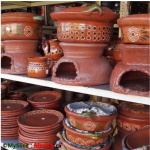
The weather is definitely turning cold in Southern Ontario, and we have had even a few frosty nights. Whatever was left of the tomato and watermelon vines died and was pulled, and perennials such as asparagus and horseradish have been trimmed to soil level and mulched, to avoid pests wintering over in the brush. A few herbs are still alive, but the stars of my late fall harvest this year are sunchokes (Helianthus tuberosus), as pictured at the top of this post.
I bought sunchoke tubers in early March this year, and decided to experiment growing some in my backyard; after sprouting indoors, I gave a couple to a friend for her garden, and the rest were successfully transplanted to my backyard in April. By the middle of summer, four plants had grown into tall stems full of green leaves (photo below, left), and in October, a few bright yellow flowers could be spotted, in spite of some slug damage (photo below, right):


The best time to harvest sunchoke tubers is after a hard frost, so I went to check the patch last week; in the photo below, left, a wrecked plant with wilted leaves may be seen collapsing to one side. When I pulled the stems, only a few tiny guys were visible, half buried in the soil (photo below, right):


However, once they were shaken, and the soil around the roots was gently dug with a trowel, numerous larger tubers could be seen (photo below, left). I separated some of the tinniest tubers from the harvest (photo below, right), and buried them back in the soil, so they may overwinter underground, and hopefully sprout in the spring:


Since sunchoke tubers do not keep well for long after harvest, I only pulled two of the plants, and cut the dead tops off the other two, leaving the subterranean parts intact, until I need more. In the photo below, my harvest of chubby sunchokes, including some with the characteristic “chicken drumstick” shape:

I brushed off as much dirt as possible from the sunchokes, washed them thoroughly, and drained them:

Sunchokes may be eaten without peeling, but some of the tips had frost damage, as seen above, so I trimmed them, and also removed any blemished spots:

Last spring, some of the store-bought sunchokes were roasted whole with olive oil, salt and freshly ground black pepper, then added to a stew. They were delicious, but portions had to be kept small to avoid digestive discomfort; sunchokes have a high content of inulin, a non-digestible carbohydrate that is fermented by gut bacteria. A way to neutralize this conspiracy in the intestinal track, is to hydrolyse the inulin with an acidic medium; that is why many people pickle sunchokes, or boil them, sliced, in lemon juice or vinegar. I decided to try the lemon juice route, so I sliced the cleaned sunchokes, and put them in a wide pan, then I added about half a cup of lemon juice, just enough to saturate all the slices (I used bottled juice, which is cheaper than lemons, photo below, left). After cooking at medium/high heat for five minutes, I poured some boiling water in, and allowed to cook for another two minutes (photo below, right):


I drained the liquid, and transferred the sunchoke slices to a non-reactive container:

Now, I had a nice batch of treated sunchoke slices, ready to be roasted, fried, or added to a stew, which is what I did. Stay tuned for the full recipe, in my next post.
I am joining Cee’s Flower of the Day (FOTD) Challenge for November 24, 2021.







I haven’t heard of sunchokes before and at first they looked like ginger root to me. Do they taste and cook like potatoes? Nice photo essay!
LikeLike
Thank you, Michael! Yes, like potatoes, but unlike potatoes, supposedly you can also eat them raw. The texture when cooked is firmer than potatoes, and they are sweet and more veggie like, not starchy.
LikeLiked by 1 person
Thanks for the reminder. I have to harvest mine soon.
Irene, I’ve often heard that the inulin breaks down relatively rapidly to a starch.
LikeLike
I have read inulin is a fructan, and hydrolysis produces fructose, not starch (long chains of glucose): https://www.agriculturejournals.cz/publicFiles/236264.pdf
Where did you hear that?
LikeLike
Wow!
Getting such result for your efforts is certainly a unique treat 🙂
LikeLike
The few times I’ve seen these in the market, I have passed them by, not really knowing what to do with them. Thanks for all this great information. I’ll definitely pick some up next time I see them!
LikeLike
I hope you like them, and the digestive-comfort treatment works for you, Jean.
LikeLike